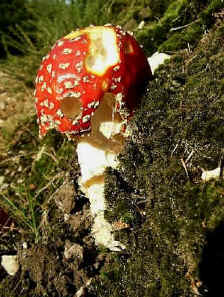Animals associated with Fungi

| At first glance, fungi might appear to be a poor place
to look for animals. However, look closely at fungal fruiting bodies and you may find an
amazing variety of associated animals. These range from minute beetles to large slugs. Fly
larvae such as fungus gnats, may be burrowing and mining through the stems of fruiting
bodies. Dor Beetles may be voraciously eating and hollowing out others. Some animals may
merely be taking advantage of the shelter, while still others, such as some beetle
species, may be carnivores, stalking and eating the other inhabitants. The fruiting bodies of fungi provide specialist habitats for a huge number of invertebrates (mini beasts). By far the greatest number are beetles and their larvae, but certain kinds of moth and fly larvae also take advantage of this source of food. Many of them can be found on a wide range of fungi, but some may only be found in very particular places. For example, a small black beetle (Dorcatoma ambjoerni), occurs only in the fruiting bodies of a particular kind of bracket fungus, growing inside hollow beech trees. Bracket fungi are popular habitats for insects to develop in because they tend to last longer than other fungal fruiting bodies. This allows more time for the insect to develop from egg to adult. Stinkhorns provide another unusual place to look for animals, in particular flies. The stinkhorn fruiting body has a slimy spore mass which smells like carrion. This attracts a range of flies such as Bluebottles, Greenbottles and Flesh-flies, amongst many others. Most animals take advantage of those fungi which just happen to be around. However, some insects carry their larder with them! Ambrosia Beetles are one example. These beetles carry ambrosia fungus with them and infect newly dead wood with the spores of the fungus. The beetle, Hylecoetus dermestoides, carries the fungal spores in its eggshells. The fungus then grows in the tunnels and galleries created in the wood by the beetle larvae, providing food for them.
|
|
The most immediately visible fungus-eaters are slugs.
In Britain, a wide variety of slugs will feast on fungus fruiting bodies, often almost
completely consuming them. The Fly Agaric toadstool on the left shows typical damage
caused by slugs. Black Slugs (Arion ater) and Ash-grey Slugs (Limax cinereo-niger) feed mostly, but not exclusively, on fungi. They can often be found on fungal fruiting bodies, causing considerable damage. Look also on bracket fungi for Tree Slugs (Limax marginatus). Not all large scale damage of fruiting bodies is caused by slugs. Dor Beetles in woodland feed primarily on rotten fungi. One beetle may end up hollowing out an entire fruiting body. Mammals such as Roe Deer will also browse on fungi.
|
